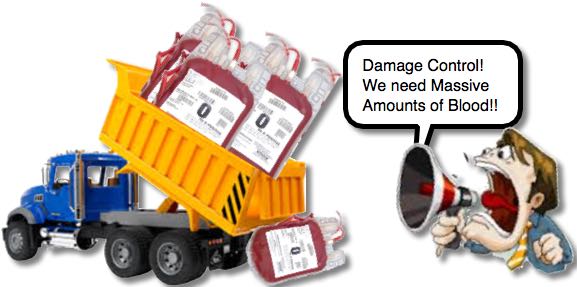Damage Control Resuscitation
Damage Control Resuscitation has been the hot topic to discuss in the adult trauma bays. Naturally, this conversation has been also heard more commonly during pediatric trauma resuscitations. What is it and does it really apply to kids? Great questions! Fortunately, a nice review article was published last month (Hughes, Ped EM Care: 2014) that I encourage you all to read… but I’ll do my best to recap.
Damage Control Resuscitation
- Strategies applied to caring for hemorrhagic shock in the severely traumatized patient.
- Fortunately, the vast majority of your pediatric trauma patients will NOT fit into this category.
- Intended for patients in whom severe hemorrhage necessitates transfusions of large-volumes of blood products.
- Aimed at helping to avoid or diminish the Lethal Triad of Trauma Management: Acidosis, Hypothermia, Coagulopathy.
- The traditional approach of giving large volumes of isotonic saline can exacerbate all of these conditions.
- Even large volumes of PRBCs can lead to electrolyte changes (ex, hyperKalemia) and coagulopathy.
- Has three core concepts:
- Acute Coagulopathy of Trauma
- Permissive Hypotension
- Massive Transfusion & Hemostatic Resuscitation
Acute Coagulopathy of Trauma
- The vast majority of healthy children do not require Coagulation studies prior to surgery (ex, the patient with appendicitis), unlike the adult population.
- Interestingly though, it has been found that pediatric trauma patients can present with acute coagulopathy associated with their trauma.
- This is distinct from the coagulopathy that can develop during the resuscitation due to administered therapies.
- Theories = tissue factor release, Protein C activation, Hyperfibrinolysis.
- Also studies that show association with Traumatic Brain Injury and acute coagulopathy.
- This does not mean that ever kid in a car crash needs 1,000 labs looking for coagulopathy, though!
Permissive Hypotension
- We all know that any hypotension that occurs during medical resuscitations is associated with higher mortality, but can hypotension be “ok” in trauma?
- Observations that patients with uncontrolled hemorrhage may have worsening shock after IV fluids seem counterintuitive.
- Perhaps the increased volume and/or pressure leads to a tenuous clot being dislodged.
- Perhaps the increased volume further dilutes the already over-utilized coagulation factors.
- Perhaps there is some other inflammatory change or cellular structure alteration (ex, swelling) as a result of the IV fluids.
- The practice of Permissive Hypotension is the plan of tolerating below normal BPs and limiting IV fluids until definitive management of the bleeding can be performed (surgery or embolization).
- What is the goal BP? Dunno.
- Ideally, you need to still maintain enough end-organ perfusion pressure to keep the vital organs alive.
- It works in animals and some adults. How about kids?
- While we are all mammals, pediatric patients may not benefit as much from this management strategy as adults or other studied animals.
- Children are able to tolerate hypovolemia much better than adults.
- Kids can compensate for up to 45% of blood volume loss prior to becoming hypotensive.
- If you already have a child that is hypotensive, you are in the very deep dark woods.
- Children are often have head injuries, which don’t respond well to hypotension.
- There have been no pediatric studies that demonstrate utility in permissive hypotension in pediatric trauma patients to date.
Massive Transfusion Protocols & Hemostatic Resuscitation
- Refers to the use of Fresh Frozen Plasma and Platelets along with Packed Red Blood Cells in ratios to approximate whole blood.
- The best ratio is not known, but often protocols use 1:1:1.
- Does it work in children?
- Cases reports of non-traumatic, intra-operative hemorrhage being successfully managed with massive transfusion protocols.
- No studies of pediatric trauma patients show any mortality benefit from massive transfusion protocols to date.
First do no harm!
- Massive Transfusions have been associated with cardiac arrest in pediatric patients.
- Transfusion-Associated Hyperkalemic Cardiac Arrest (TAHCA) is rare, but can occur.
- Possible strategies to reduce the risk of TAHCA:
- Use fresher RBCs for massive transfusions
- Use Large Bore PERIPHERAL IVs instead of central lines (remember there is more resistance in a long central line)
- Check for and correct electrolyte abnormalities frequently.
References
Hughes NT1, Burd RS, Teach SJ. Damage control resuscitation: permissive hypotension and massive transfusion protocols. Pediatr Emerg Care. 2014 Sep;30(9):651-6; quiz 657-8. PMID: 25186511. [PubMed] [Read by QxMD]
Lee AC1, Reduque LL, Luban NL, Ness PM, Anton B, Heitmiller ES. Transfusion-associated hyperkalemic cardiac arrest in pediatric patients receiving massive transfusion. Transfusion. 2014 Jan;54(1):244-54. PMID: 23581425. [PubMed] [Read by QxMD]
Sesok-Pizzini D1, Pizzini MA. Hyperkalemic cardiac arrest in pediatric patients undergoing massive transfusion: unplanned emergencies. Transfusion. 2014 Jan;54(1):4-7. PMID: 24405303. [PubMed] [Read by QxMD]
Parker RI. Transfusion in critically ill children: indications, risks, and challenges. Crit Care Med. 2014 Mar;42(3):675-90. PMID: 24534955. [PubMed] [Read by QxMD]
Nosanov L1, Inaba K, Okoye O, Resnick S, Upperman J, Shulman I, Rhee P, Demetriades D. The impact of blood product ratios in massively transfused pediatric trauma patients. Am J Surg. 2013 Nov;206(5):655-60. PMID: 24011571. [PubMed] [Read by QxMD]
Chidester SJ1, Williams N, Wang W, Groner JI. A pediatric massive transfusion protocol. J Trauma Acute Care Surg. 2012 Nov;73(5):1273-7. PMID: 23064608. [PubMed] [Read by QxMD]
Chidester SJ1, Williams N, Wang W, Groner JI. A pediatric massive transfusion protocol. J Trauma Acute Care Surg. 2012 Nov;73(5):1273-7. PMID: 23064608. [PubMed] [Read by QxMD]
Dehmer JJ1, Adamson WT. Massive transfusion and blood product use in the pediatric trauma patient. Semin Pediatr Surg. 2010 Nov;19(4):286-91. PMID: 20889085. [PubMed] [Read by QxMD]



[…] discussed several topics related to shock previously (ex, Epi vs Dopa, Pediatric Shock Index, and Damage Control Resuscitation), but now let us focus on recognizing SHOCK and one important aspect – Capillary […]
[…] Ped ED; however, sometimes, the illness is not subtle and the child requires critical actions (ex, Damage Control Resuscitation, Mechanical Ventilation, Optimize Chest Compressions) . Often, it is best to consider these […]